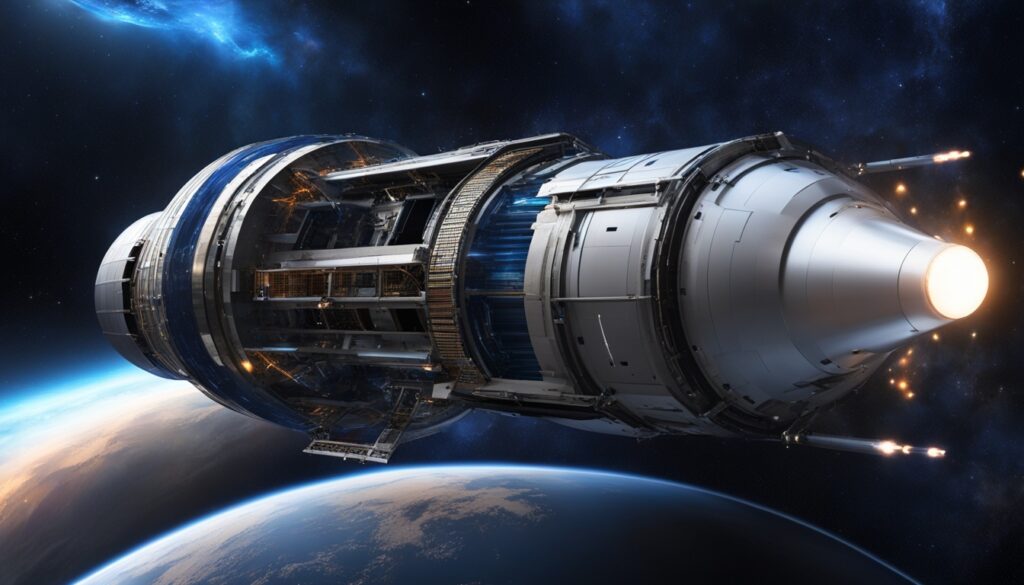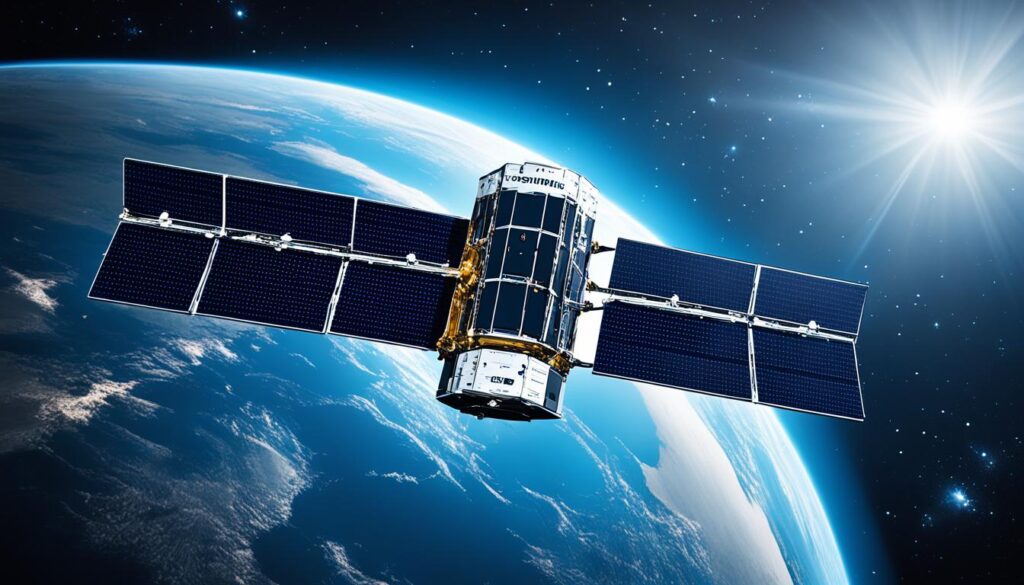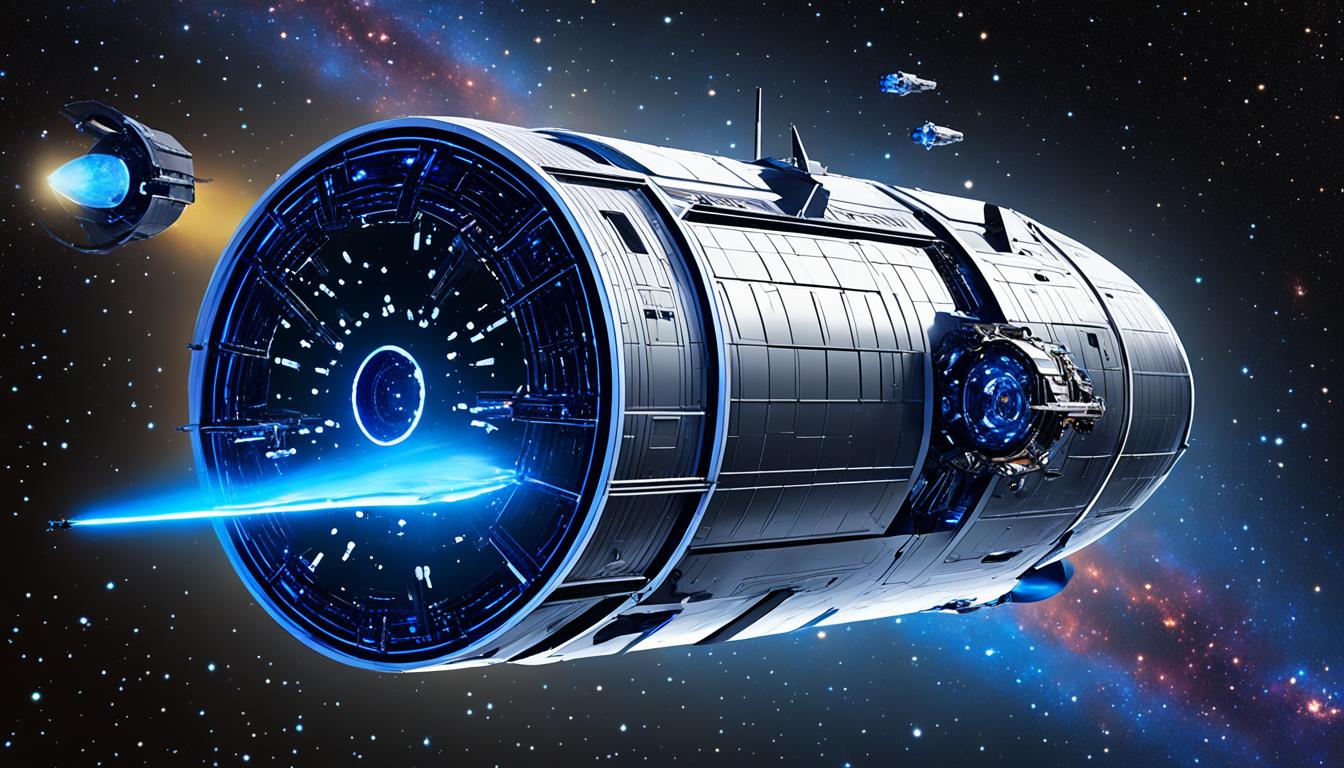“As an Amazon Associate I earn from qualifying purchases.” .
Exploring space is all about using fuel wisely and getting every push right. ThrustMe is changing how we move spacecraft and satellites. They’ve created a new electric propulsion system that is making big waves.
Their system uses the power of ion thrusters and xenon propellant. This means spacecraft can move better and with less impact on the environment. Their Hall-effect thrusters give a slow but steady push, perfect for making small orbit changes and lasting longer on missions.
Key Takeaways
- ThrustMe has developed a revolutionary electric propulsion system for spacecraft and satellites.
- Their technology utilizes ion thrusters and xenon propellant for efficient and sustainable propulsion.
- Hall-effect thrusters provide precise orbital maneuvering capabilities.
- The system offers extended mission durations and reduced fuel consumption.
- ThrustMe’s innovation is poised to transform satellite propulsion systems and space exploration.
ThrustMe: Pioneering Electric Propulsion Technology
In 2016, ThrustMe’s founders saw a big chance in electric propulsion research. They moved from just theories to building real models. Supported by SATT Paris-Saclay, they put together a skilled team. Together, they proved the NPT30 propulsion systems can do big things in space, all from small, CubeSat-sized units.
Incorporating ThrustMe
ThrustMe became a real company in 2017. They got more than 2 million euros to grow. They also got the rights to use the patents from their electric propulsion research. By the end of that year, a team of ten top experts was ready to push spacecraft propulsion technology further.
Raising Capital and Acquiring Licenses
ThrustMe’s work on satellite propulsion innovations wasn’t ignored. It brought in big investments. These funds helped a lot. They let ThrustMe build on their ideas. They could keep working on their ThrustMe ion thrusters and similar systems without worrying about others copying their hard work.
| Propellant | Performance Enhancement | Storage Density |
|---|---|---|
| Iodine | 50% higher than xenon | 3x higher than xenon, 9x higher than krypton |
| Xenon | – | Rare, less than 1 part per 10 million in the atmosphere |
| Xenon | – | Expensive, costing around $3000/kg |
The table makes it clear why iodine is great for ThrustMe ion thrusters. It beats xenon in how well it helps spacecraft move and how much can be stored. This shows just how good ThrustMe’s spacecraft propulsion technology is for the space industry’s future needs.
ThrustMe develops an Electric Propulsion System
ThrustMe has made a big move in electric propulsion. They won a contract from ESA GSTP to work on the NPT30-I2-1.5U system. This system uses ion thrusters and will change how we move satellites.
The space industry is changing fast. There’s a big need for better, greener ways to move in space. Electric propulsion systems like the NPT30-I2-1.5U are stepping up. They can do all the moves needed for satellite groups.

ThrustMe’s electric propulsion system, the NPT30-I2-1.5U, is key for moving satellites up, down, and into place. This tech is a big deal. After six decades of work, ThrustMe showed the first space test of an electric system using iodine fuel.
| Feature | Description |
|---|---|
| Propulsion System | NPT30-I2-1.5U |
| Propellant | Iodine |
| Thruster Type | Ion Thrusters Xenon |
| Application | Satellite Propulsion |
ThrustMe is at the forefront with innovative space movement solutions for today’s fleets of satellites. They give top-notch ways to move in space to clients all over the world. Their work is based in the outskirts of Paris, France.
Groundbreaking Iodine Propulsion System
ThrustMe’s iodine electric propulsion systems are turning heads in the space world. The NPT30-I2-1U is a prime example of their work. It’s seen as a new, exciting way to move through space. Just last year, their I2T5 system was put to the test in space and showed great promise.
Successful In-Orbit Demonstration
ThrustMe made big waves on December 28, 2020, and January 2, 2021. They used their NPT30-I2-1U system on the Beihangkongshi-1 satellite. This test proved the system works, changing the satellite’s height by 700m. It’s a huge step forward for spacecraft movement.
Advantages of Iodine Propellant
What makes ThrustMe’s iodine propellant so special? Well, it’s better than the usual xenon in many ways. It’s easier to set up, better for the environment, and deals with a big, upcoming problem. Soon, we might not have enough xenon for all the spacecraft. But, iodine can help with that problem.
By using iodine, space companies can save time and be greener. With the increasing number of satellites going up, this is a key advantage. It ensures these missions can keep going without running out of essential resources.
Enabling Satellite Constellations
The space industry is changing fast with the rise of satellite constellations. They are small and ready-made for Earth observation and many-spot tracking. In this shift, electric propulsion systems are key. They use ion thrusters for moving satellite constellations efficiently in space.
Meeting Demands for Earth Observation
A groundbreaking change happened when the first commercial C-band small satellite SAR launched in 2020. It uses a unique ThrustMe NPT30-I2-1U electric propulsion system. This system is vital for keeping the satellite’s orbit, avoiding collisions, and safely de-orbiting it over its three-year mission.
Synthetic Aperture Radar Constellations
ThrustMe’s innovative NPT30-I2-1.5U electric propulsion system will support a GomSpace mission. This SAR satellite constellation needs to position its satellites precisely. The choice of ThrustMe’s system highlights a demand for eco-friendly, efficient systems in modern space missions.
| Feature | ThrustMe NPT30-I2 | Traditional Electric Propulsion |
|---|---|---|
| Propellant | Iodine | Xenon |
| Integration | Turnkey, pipe-less | Complex, separate components |
| Cost | Economical | High propellant cost |
| Sustainability | Abundant, eco-friendly | Scarce, supply disruptions |
ThrustMe’s NPT30-I2 with iodine is making on-orbit propulsion easier and cheaper. This addresses the upcoming shortage of xenon. By 2025, the demand for xenon is likely to be more than what we can produce. This will drive up its price, leading to problems for the space industry.
Solving Emerging Space Challenges
ThrustMe, with help from the French state and the European Commission, celebrated their first milestone. It was with the European Space Agency through the ARTES C&G program. This first step in the ESA propulsion contract project is crucial for dealing with issues linked to the growing number of satellite networks.
ESA Contract for Breakthrough Technology
Today’s propulsion methods face challenges for future satellites. Conventional chemical and electric propulsion systems have their drawbacks. ThrustMe’s innovative approach offers a more efficient and eco-friendly option.
Addressing Propellant Scarcity
The space community is facing a critical issue – running out of xenon propellant. This demand could double the global supply in the next decade, caused by the space industry’s satellite use. ThrustMe’s new iodine system provides a sustainable solution for satellite propulsion.

| Technology | Advantages | Industry Support |
|---|---|---|
| ThrustMe’s NPT30 Iodine Electric Propulsion System |
|
|
“ThrustMe’s iodine technologies were supported by the French Space Agency, CNES, as part of their R&T program, highlighting the strategic importance of iodine propulsion for the space industry.” – Thomas Lienart, Head of the Propulsion, Pyrotechnics and Aerothermodynamics office at CNES
Collaborations and Support
ThrustMe’s new iodine electric propulsion system is getting big help and CNES collaboration from top space groups. They see how crucial it is for space. The French space agency support in 2019 really boosted ThrustMe’s work on iodine tech.
Partnership with CNES
The Centre National d’Études Spatiales (CNES), France’s space agency, is all in on helping ThrustMe with their iodine system. They started a special project in their R&T program for it. This CNES collaboration shows how vital iodine propulsion is for the space future.
Because of this teamwork, ThrustMe is moving ahead fast with iodine propulsion. The CNES collaboration means more precise testing, making sure the system works well and doesn’t fail.
ThrustMe is also growing and making more ThrustMe partnerships with top companies. CNES’s support honors ThrustMe’s tech skills and the huge change their iodine system can make.
| Agency | Program | Support Provided |
|---|---|---|
| CNES | R&T Program | Development of iodine propulsion system |
| ESA | ARTES Program | Competitiveness and growth initiatives |
With strong support from big space agencies like CNES and the European Space Agency (ESA), ThrustMe is ready to push forward with their new propulsion tech. They aim to change how we explore space, making it more sustainable and efficient.
Executive Insights
The space world is tackling electric propulsion challenges, especially for smaller satellite missions. Ane Aanesland, the head of ThrustMe, pointed out the issues with gas propellants. She spoke about their dangers and high costs from testing to launch, mainly for shared missions.
ThrustMe is working on an innovative iodine thruster technology to overcome these challenges. Dmytro Rafalskyi, the company’s technical officer, mentioned they were building from their cold gas system, I2T5. They are also using advanced plasma and beam technologies. This progress is for the new NPT30 system that uses iodine for propulsion.

This innovative approach has received support from major space agencies. The European Space Agency (ESA) and the French Space Agency (CNES) back ThrustMe’s work with iodine propulsion. They’re supporting the demonstration through the ARTES C&G program.
Ane Aanesland on Propellant Challenges
Ane Aanesland, CEO of ThrustMe, talked about the hurdles with gas propellants. She mentioned their risks and the high costs from testing to launch, especially for shared missions.
Dmytro Rafalskyi on Iodine Propulsion Development
Dmytro Rafalskyi, CTO of ThrustMe, explained how they’re advancing. They’re building on their cold gas system, I2T5. Plus, their plasma and beam technologies are being used for the new NPT30 iodine propulsion system.
ESA and CNES Endorse ThrustMe’s Solution
The European Space Agency (ESA) and the French Space Agency (CNES) are confident in ThrustMe’s iodine propulsion solution. They support its demonstration through the ARTES C&G program.
| Company | Founded | Location | Offerings |
|---|---|---|---|
| Exotrail | 2015 | Massy, France | High-thrust propulsion systems |
| Morpheus Space | 2018 | Los Angeles, California | Electric propulsion systems, mission analysis tools |
| Prime Lightworks | – | – | Electric propulsion systems, reduced fuel consumption |
| Benchmark Space Systems | 2017 | Burlington, Vermont | Propulsion systems for spacecraft |
| Bellatrix Aerospace | 2015 | Bangalore, India | In-space propulsion systems, orbital launch vehicles |
| Bellatrix Aerospace | – | Bengaluru, India | Satellite propulsion technologies, electric, green, and nano propulsion systems |
Environmental and Economic Sustainability
ThrustMe’s new iodine electric propulsion system is changing the game in space travel. It’s both sustainable and cost-effective. Current systems use rare gases like xenon or krypton. But these are pricey and hard to find. They also need complex pressurization. This raises costs and makes things more complicated.
However, iodine propellant is easy to get, cheap, and doesn’t need to be pressurized. This makes adding it to satellites easier. This new tech is set to make a big difference. It will make satellites more eco-friendly and boost the economy.
Experts predict a huge demand for xenon soon, more than the world can make. SpaceX is choosing krypton for its Starlink satellites. But for over ten years, people have seen iodine as a great alternative. It’s denser, simpler to store, and costs less than xenon.
Iodine is highlighted as a breakthrough in the satellite industry due to its ability to simplify the satellite integration process and offer economic and environmental sustainability.
| Propellant | Cost | Availability | Storage |
|---|---|---|---|
| Xenon | High | Scarce | Pressurized |
| Krypton | High | Limited | Pressurized |
| Iodine | Low | Abundant | Unpressurized |
This table shows why iodine is better than xenon and krypton. It’s cost-effective and good for the environment, making it perfect for space missions.
Future Prospects for ThrustMe
ThrustMe has developed an innovative iodine propulsion technology. This tech has been proven in space through successful missions. It puts the company at the forefront for solving space industry problems. These creative solutions provide a sustainable, affordable way to power satellites.
The future looks bright for ThrustMe. The demand for new space engines is growing, especially for small satellites. With support from business, education, and government, ThrustMe can expect a growing market.
ThrustMe introduced the LTA series, commercialized plug-and-play products generating Very Low Earth Orbit (VLEO) and Low Earth Orbit (LEO) environments in the lab. The LTA series simplifies changing the effective “altitude” of equipment with the press of a button, offering a broad range of operation parameters using various gases and mixtures.
ThrustMe is working towards larger testing facilities and more products. It has the DRAG-ON lab, created with the von Karman Institute. This lab can replicate conditions 200 km above Earth. The research here covers a space between the edge of space and the International Space Station.
| Technology | Description | Key Advantages |
|---|---|---|
| Iodine Electric Propulsion | Utilizes iodine propellant for efficient and sustainable propulsion | Prefilled, simplified integration, and environmentally friendly |
| LTA Series | Simulates VLEO and LEO environments in the lab | Plug-and-play, broad range of operation parameters |
| DRAG-ON Facility | Simulates high-speed, low-density flow at various altitudes | Expands testing capabilities for space hardware |
ThrustMe’s advanced tech and proven success look promising for the future. It’s set to greatly impact space propulsion. This will lead to more sustainable and effective space exploration.
Conclusion
ThrustMe is a leading company in space tech. They’ve made a cutting-edge electric propulsion system that uses iodine. This is a big step forward compared to old systems that use xenon. Thanks to their hard work, ThrustMe is helping make space travel both sustainable and efficient. This innovation supports the new era of space exploration and missions to observe Earth.
ThrustMe’s NPT30-I2-1U system is a game-changer. It works in space, showing how big this tech can be. It uses iodine, which is easy to find and cheaper than xenon. With xenon running low because of more satellites, iodine is the way to go.
They’re not doing this alone. ThrustMe has big names like the ESA and CNES helping them out. Together, they’re making advancements in propulsion. This shows the key role iodine propulsion plays in our space future. Plus, it meets the need for eco-friendly ways to power satellites.
FAQ
What type of propulsion system does ThrustMe develop?
What is unique about ThrustMe’s iodine propulsion system?
Has ThrustMe’s iodine propulsion system been tested in space?
What are the applications of ThrustMe’s propulsion systems?
What challenges is ThrustMe addressing with its iodine propulsion technology?
What partnerships and support has ThrustMe received?
What are the advantages of ThrustMe’s iodine propulsion system?
“As an Amazon Associate I earn from qualifying purchases.” .



